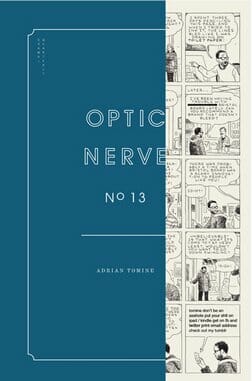Optic Nerve #13 by Adrian Tomine

Writer & Artist: Adrian Tomine
Publisher: Drawn & Quarterly
Release Date: July 31, 2013
The first story in this issue of Optic Nerve, which keeps on coming out with persistence if not regularity, serves as a perfect explanation of why Adrian Tomine continues to work in his unique format. A dense one-pager visible behind the half-page cover, “Winter, 2012” consists of the artist’s travails when he discovers his regular brand of Bristol board suddenly starts to bleed when inked. He complains at the art supply store, only to be steered toward a tablet solution, which he grumps about. At the bookstore, the book he’s looking for isn’t available, and the sales clerk tells him he should just order it from Amazon. His post office box still has correspondence in it, but even there he’s upbraided for his Luddism in refusing to migrate online.
The beauty of Optic Nerve and of the comics format in general, as both this short story and the letters on the last page of the thin booklet argue, lies exactly in its ephemeral nature. Here is something made the way the artist wants it. It is not reaching the largest possible audience. It is not going viral. It is a controlled and limited environment. And that is both unusual and pleasurable.
-

-

-

-

-

-

-

-

-

-

-

-

-

-

-

-

-

-

-

-

-

-

-

-

-

-

-

-

-

-

-

-

-

-

-

-

-

-

-

-










































